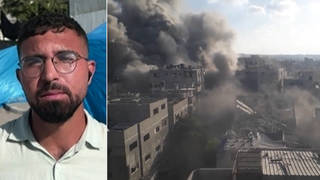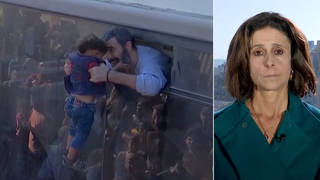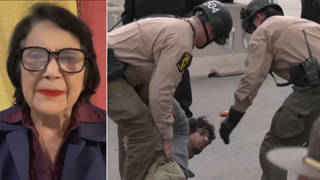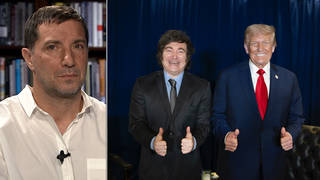
We speak with the Toledo Blade reporter who uncovered this month massacres committed by U.S. troops in Vietnam on the scale of My Lai that had gone unreported for 36 years. Tiger Force troops torched villages, executed prisoners, and slaughtered unarmed farmers as well as their wives and children, killing hundreds. [includes transcript]
A report this month in the Toledo Blade uncovers massacres committed by U.S. troops in Vietnam that has gone unreported for 36 years.
In a story that has never been told, an elite platoon torched villages, executed prisoners, and slaughtered an untold number of unarmed civilians between May and November, 1967.
The platoon was called Tiger Force. A small, highly trained unit of 45 paratroopers, Tiger Force was created to spy on enemy forces in one of the most highly contested areas of South Vietnam: the Central Highlands.
For seven months in 1967, they violently lost control and carried out the longest series of atrocities in the Vietnam War.
As their commanders looked the other way, Tiger Force troops dropped grenades into underground bunkers where women and children were hiding. They shot unarmed civilians, in some cases as they begged for their lives. They frequently tortured and shot prisoners, severing ears and scalps for souvenirs.
After learning about the atrocities a few years later, the Army investigated the platoon for 4 1/2 years, finding numerous eyewitnesses and substantiating war crimes. The case reached the highest levels of the Pentagon and the Nixon White House. But in the end, no one was prosecuted and the case buried in the archives for three decades.
- Michael Sallah, national affairs writer for Block News Alliance, which consists of the Toledo Blade and the Pittsburgh Post Gazette. He and his colleague Mitch Weiss have published a series of reports on the Tiger Force platoon in the Toledo Blade titled 'Buried Secrets, Brutal Truths'
- Tape: Former Tiger Force team leader Sgt. William Doyle speaking with the Toledo Blade’s Mitch Weiss describing the mentality of Tiger Force soldiers.
- Tape: Former Tiger Force team leader Sgt. William Doyle speaking with the Toledo Blades Mitch Weiss describing killing farmers as they planted rice.
- Tape: Former Tiger Force member Sgt. Gerald Bruner recalling an incident in an attack on a village. Bruner died of cancer six years ago. This was recorded in 1988.
AMY GOODMAN:Michael Sallah joins us on the phone from Washington, D.C. Welcome to Democracy Now!
MICHAEL SALLAH: Greetings.
AMY GOODMAN: How did you first hear about this story?
MICHAEL SALLAH: Well, we were — Our Washington bureau was made aware of 22 classified Documents that a top-level former official of the Army had passed on, never fell right about the case, always felt that this was one that was not handled properly and I think that in his own sense of doing the right thing, he passed it on.
AMY GOODMAN: Can you talk about the particular stories that you uncovered? Tell us about a village, when the Tiger-Force came in.
MICHAEL SALLAH: Well, there was a lot of stories and the soldiers certainly gave very detailed and very direct accounts of what happened. Both to C.I.D. investigators, three decades ago and many of them to us even today. An example would be when the Tiger-Force came upon a small hamlet in the Song-Vay valley in July of 1967. They were elderly farmers. They were five men, five women. They were all out in the field. They felt they were safe, partly because they were not of military age and secondly because these were their ancestral ties. This was their land. They didn’t really want to go to relocation-camps. They were not very pleasant places to go and they were clearly just toiling away in the field when the commander of Tiger-Force gave the orders, “open fire.” Some of the soldiers did fire on the elderly farmers. Some refused to. In the end, at least four were killed. Many more were wounded. The others, I think a couple that did survive, managed to play dead in the field, in the muck, until the soldiers moved on and that was an example of where Tiger-Force just continued to want to basically clear the land so that there would be no people there. That way they could be assured that there would be no Vietcong. In the process they killed innocent people. Another instance would be when they came upon a hamlet near Chu-Lai in November of ë67. They clearly saw numerous women and children run as they would always trained to do, these women and children — they were families largely, and family 20s would be living in a hootch — they would have their own bunkers. There are with three bunkers. Three families went and they hid into the bunkers. The soldiers saw them do so. They went up to the entranceways and, instead of bringing an interpreter or trying to call them out, they simply unclipped their grenades, threw them in and created mass underground-graves. This, according to the soldiers went on a lot. This was one particular instance that four soldiers saw, they witnessed and they later told their versions to the investigators.
AMY GOODMAN: Michael Sallah, I wanted to play a clip from one of the soldiers, former Tiger-Force team leader sergeant William Doyle and in this, he’s speaking with your colleague. You wrote this expose with, Mitch Weiss.
WILLIAM DOYLE: We just didn’t care, you know, what everybody did out there. Everybody was supposed to cover each other’s ass. If they didn’t, they were in mortal danger.
MITCH WEISS: Mm-hmm.
WILLIAM DOYLE: And that’s just the way it was.
MITCH WEISS: How were you living day-to-day?
WILLIAM DOYLE: We didn’t expect to live. Nobody out there with any brains expected to live.
MITCH WEISS: Mm-hmm.
WILLIAM DOYLE: You know, you did any God damn thing you felt like doing.
MITCH WEISS: Mm-hmm.
WILLIAM DOYLE: You’re surprised you’re still alive next week, so, you know, you do any God-damned thing you felt like doiní.
MITCH WEISS: Mm-hmm.
WILLIAM DOYLE: And especially to stay alive. I’m not saying you give up and die. You still gotta live but the way to live is to kill, because you don’t have to worry about anybody thatís dead, but you have to worry about the living The first idea that crosses your mind, you pull the trigger. If it just crosses your mind, you pull the trigger.
MITCH WEISS: So, in other words, if you went into a ____ you weren’t sure —
WILLIAM DOYLE: If I walked into a village and everybody wasn’t postured on the ground, I shot those standing up.
AMY GOODMAN: ìI shot those standing up,î saying ìyou didn’t have to worry about those who were dead. You only had to be concerned about the living.î
MICHAEL SALLAH: Yeah. William Doyle offers no remorse or apologies for what he did. He said he would do it all over again. I think if his — One of his other lines was that if —- He clearly felt that the war ended too soon. He says, ìIf I had known the war was gonna end that soon, I would have killed more.î That was his version of events. He -—
AMY GOODMAN: Well, let me play one more comment of former Tiger-Force team-leader sergeant William Doyle, again speaking with the “Toledo blade’s” Mitch Weiss, describing killing farmers as they planted rice.
WILLIAM DOYLE: Well, some of ëem kept on plantiní rice. You don’t put your head up to look at somebody when you’re planting rice.
MITCH WEISS: Mm-hmm.
WILLIAM DOYLE: You know, you don’t kill with a look.
MITCH WEISS: Mm-hmm.
WILLIAM DOYLE: _____
MITCH WEISS: So they were killed because they looked at you guys? Is that what happened?
WILLIAM DOYLE: Yeah, more or less. It comes to your attention, you pull the trigger.
MITCH WEISS: Mm-hmm.
WILLIAM DOYLE: You know? If it crosses your mind to pull the trigger, you want to live, you pull it.
MITCH WEISS: Mm-hmm.
WILLIAM DOYLE: Any mistake you make you make in your own favor.
AMY GOODMAN: ny mistake you make, you make in your own favor.” We actually reached sergeant William Doyle on the phone. He wouldn’t come on with us today. But he did say blame it all on me. Blame it all on me. Don’t blame it on anyone else. It’s all my fault. Your response to that, Michael Sallah?
MICHAEL SALLAH: No, it’s not all his fault. It was partly his fault, but there was a culture in the unit that it was a kill-unit and the leadership of the unit, all the way up to the commanders, knew what they were doing. They looked the other way. They allowed it to happen. Now, William Doyle was one of many who were involved in these atrocities and he’s not alone.
AMY GOODMAN: Let’s hear former Tiger-Force member sergeant Gerald Brunner recalling an incident, an attack on a village. Brunner died of cancer died six years ago. This was recorded in 1988. Sergeant Gerald Brunner.
GERALD BRUNNER: I come running around the corner. This guy was running and they fired at him and the guy fired his M-79 grenade-launcher and a round hit this guy in the head and the guy ought to be glad it didn’t go off because it would have messed some of us up but, instead, again, I this guy got hit in the head and the round didn’t go off. It killed him and when he — It hit his head and it just exploded and brains were all over me and this sort of thing and — within that — that really pissed me off and so my guys came in to see what was going on, so here we are, we’re almost fighting our own people. I mean, to me, this is what you call murder. I mean, they — they murdered the guy.
AMY GOODMAN: And that’s sergeant Gerald Brunner. He died six years ago of cancer. He pulled his weapon on other U.S. troops to try to stop them from, well, what heís saying — murdering villagers.
MICHAEL SALLAH: There were a couple of people, including Gerald Brunner, who tried to stop the violence against the villagers — the unarmed villagers. They clearly felt this was wrong, it is not — It violates not only the Army’s rules of engagement, but international law and the laws of humanity but they were transferred out — not only Gerald Brunner, but lieutenant Donald Wood who tried to countermand orders by his platoon commander to stop the carnage, if you will, and — so there were a couple of brave souls out there, clearly trying to stop, but who later took their — almost immediately took their complaints to commanders and the commanders in both cases, clear — just basically blew them off.
AMY GOODMAN: And they were sent to… he was, at least, Brunner ñ sent to a psychiatrist?
MICHAEL SALLAH: Yes. They though that for you to put your gun on another soldier, you must be crazy. We’re going to send you a psychiatrist. Of course, Gerald Brunner went ahead and told the psychiatrist, “This is wrong. You can think I’m crazy, but what they are doing is wrong.”
AMY GOODMAN: Michael Sallah, you and Mitch Weiss, who did this expose in the “Toledo blade,” are in Washington, talking to Congress-members and Pentagon-officials about whether or not there will be a follow-up investigation. What’s been the response?
MICHAEL SALLAH: Well, I think at this point, I believe that the Pentagon is considering — They’re taking a hard look at the case. I don’t know. My sense is that unless they’re called upon to reinvestigate, they will probably just do their own evaluation. I believe they’re looking at it now. They have a lot of work to do. There is a lot of archived can documents to go through. Thereís a lot of people to talk to. Our investigation took eight months. Even with a team of people at the Pentagon, it’s gonna take a while. Members of Congress have, in some cases, are still starting to — They’re still actually reading the series and I believe Dennis Kucinich is writing a letter to the Pentagon. I believe there may be a couple others that are joining him.
AMY GOODMAN: And what is your — What is your sense of how many more massacres there are to uncover? I mean, when you think about My Lai and the profound effect that this had, this expose had on a country, are you beginning to see the same response from the piece and your paper, “the Toledo Blade”?
MICHAEL SALLAH: Well, yeah. I believe the response we’ve gotten, we’ve gotten both, you know, thereís been people that have wanted this to be continued, that we should look at these very carefully and they’ve clearly applauded our efforts at looking at this again. Others have been very critical, almost in the same way they were when My Lai came out: ìHow could you do this? We’re in the middle of a war.î
AMY GOODMAN: And the Pentagon? Its response?
MICHAEL SALLAH: The Pentagon’s response has been, surprisingly… It was very refreshing to hear a couple of the J.A.G.’s, who we interviewed — one in particular — say that we need to look at this. This was something that, that was the old Army. Itís not the new Army and, if this is something from the past that was covered up, it needs to be — and he applauded our efforts.
AMY GOODMAN: Well, on that note, I want to thank you very much for being with us.
MICHAEL SALLAH: Sure.
AMY GOODMAN: That’s Michael Sallah of “the Toledo Blade” and you can see this piece on their website.











Media Options